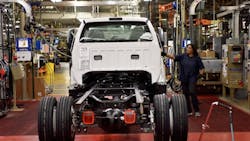The true strength of the American labor market may be disguised.
Wage growth--described as slow and unconvincing by Federal Reserve officials plotting their path to higher interest rates--is more robust by some measures than commonly acknowledged due to changes in the composition of the workforce. With unemployment close to the lowest in eight years, accelerating pay gains would force Fed Chair Janet Yellen to step up her gradual approach to lifting borrowing costs if inflation starts to rise.
Policy makers have identified wages as one of the most disappointing features in a labor-market recovery that has seen the biggest back-to-back annual payroll gains in 16 years, the jobless rate cut in half and a recent surge in the labor force. The data are being distorted by the retirement of highly paid baby boomers just as lower-wage workers re-enter the workforce after being sidelined during the last recession, according to Fed analysts.
“The signal is muddied so we shouldn’t use it as an indicator that the labor market is weaker than we observe when we look at the unemployment rate,” Mary Daly, associate director of research at the San Francisco Fed, said in an interview. “Absent the changes in labor-force composition, we would have seen wage growth come up more consistently with the decline of unemployment.”
Data Flood
Measures of the state of the labor market are abundant and range from job openings to hiring, layoffs to voluntary quits, and payrolls to various forms of underemployment and joblessness. The unemployment rate stood at 5% last month. A gauge of labor-market conditions published by the Fed on Monday fell by 2.1 index points in March, marking the third consecutive decline.
Yellen’s dashboard contains nine indicators, not including the vast array of wage-growth gauges such as unit-labor costs, the employment-cost index, compensation per hour and average hourly earnings. The latter, which rose 2.3% in March from a year earlier, is probably the best yardstick for inflation because it tracks employers’ total wage bill -- but also one that masks underlying trends that Daly has zeroed in on.
In a recent research paper with Bart Hobijn, an economics professor at Arizona State University, and Benjamin Pyle, a research associate at the San Francisco Fed, she argued that the disproportionate firing of low-wage workers during the 2008-2009 recession propped up aggregate wage measures at the time. Bringing those workers back into the labor force is now a drag on pay growth. It’s amplified by the retirement of those born during the baby boom between 1946 and 1964, who make up more than 20 percent of the American population.
Gauges focusing on those continuously employed may thus better capture pay dynamics. The Atlanta Fed’s wage-growth tracker is one such measure. In February, the last month for which data are available, it signaled gains of 3.2%, compared with an average of 2.8 percent over the past decade.
“We almost look at it as another sign of relative tightness in the labor market,” John Robertson, a research economist and senior policy adviser at the Atlanta Fed, said in an interview. “It doesn’t allow us however to connect that wage growth to inflation because for a business it’s really about the total wage bill at the end of the month.”
Yellen has acknowledged anecdotal evidence and said that “quite a number of reports” show wages are picking up, but the aggregate data don’t yet reflect it.
“I do see broad-based improvement in the labor market, and I’m somewhat surprised that we’re not seeing more of a pickup in wage growth,” she said March 16, after policy makers kept interest rates unchanged and lowered their forecasts for how quickly they will raise borrowing costs this year. “That suggests to me that there is continued slack in the labor market.”
Crucial Assessment
That assessment is crucial for monetary policy. Typically, wages pick up when the jobless rate drops significantly as employers boost pay to fill vacancies and retain staff. That, in turn, would fuel inflation as they raise prices to offset the higher costs, increasing the need for higher interest rates. The U.S. central bank began raising its benchmark federal funds rate from near-zero in December, marking the first hike in nearly a decade, and currently predicts two increases this year.
Wage growth, by any standard, has in the most recent recovery been below the 3.5 percent to 4 percent range historically observed. With the Fed’s preferred inflation gauge currently running at half the central bank’s 2 percent target rate, and last year’s increase in productivity a mere quarter of the average over the past two decades, it could be that current pay gains actually aren’t out of line with those economic fundamentals.
Even though inflation and productivity are expected to pick up, Daly predicts wages won’t resume their past path of expansion for another two to four years as lower-skilled workers are integrated into the labor force. With those employees likely to be less productive than those who retire, the labor market may be getting tighter than comparatively tepid wage growth would suggest.
So what’s the takeaway?
“We don’t have any perfect measure of wage growth,” Daly said. “It’s time for people to turn their attention to it and dig in. We’re just starting to discuss these issues.”
About the Author
Bloomberg
Licensed content from Bloomberg, copyright 2016.
